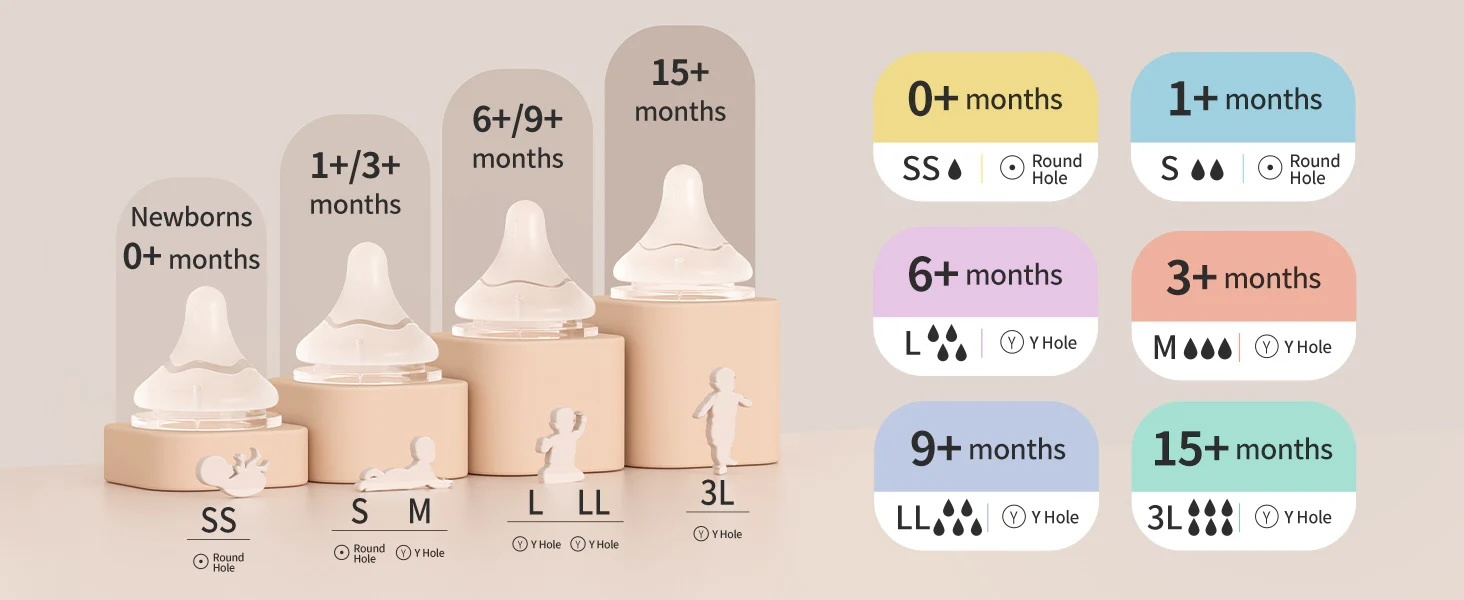How to Choose the Right Pigeon Nipple Size
Posted by info@babysquare.ca BigCommerce on 2025 Aug 15th
How to Choose the Right Pigeon Nipple Size
A quick, parent-friendly guide based on Pigeon’s design principles and real-world feeding cues.
Why fit matters
The correct nipple size helps your baby feed comfortably, lowers the chance of choking or gas, and supports healthy oral development. Pigeon nipples are built on over 60 years of research into the natural breastfeeding motion and are designed to work smoothly with breast and bottle.
Three stages of a natural feed
- Latch-on (Kyuchaku): A wide, breast-like base helps babies latch easily and reduces air intake.
- Peristaltic tongue movement: A wave-like tongue motion compresses the nipple to draw milk; Pigeon’s softness and thickness support this action.
- Swallowing: Steady flow lets babies drink and swallow at a comfortable pace appropriate to their growth.
Tip: Start with the suggested size for your baby’s age, then adjust up or down based on actual feeding behavior.
Nipple sizes & recommended age

| Age Range | Size | Hole Type | Flow & Notes |
|---|---|---|---|
| 0+ months | SS | Round Hole | Slowest, drop-by-drop flow for newborns and combination feeding. |
| 1+ months | S | Round Hole | Slow flow for babies who take smaller amounts more slowly. |
| 3+ months | M | Y-Cut | Medium flow for growing suction strength. |
| 6+ months | L | Y-Cut | Faster flow; suits babies starting solids with stronger suction. |
| 9+ months | LL | Y-Cut | Fast flow for larger intake and quicker drinking. |
| 15+ months | 3L / LLL | Y-Cut | Fastest flow for toddlers with mature swallowing. |
How to tell it’s time to change size
- Feeds take too long (often over 20 minutes) → flow may be too slow; try the next size up.
- Milk spills, coughing, or gagging → flow may be too fast; go one size down.
- Chewing the nipple or refusing to suck → flow rate doesn’t match baby’s preference.
- Nipple collapses during feeds → suction is strong for the hole size or silicone is worn.
Usage & care
- Clean after each use with a dedicated nipple brush and disinfect regularly.
- Store in a dry, hygienic place and keep out of children’s reach when not in use.
- Replace nipples periodically to avoid silicone wear and maintain safe, consistent flow.
Common Questions (FAQ)
Q: Can I choose a bigger size so my baby drinks faster? A: Not recommended. Too-fast flow can lead to coughing, choking, or overfeeding. Start with the age-appropriate size.
Q: Round hole vs. Y-cut — what’s the difference? A: Round holes (SS/S) give a steady slow stream for young babies. Y-cut (M and above) opens more as baby sucks, allowing higher flow for older babies.
Q: How often should I replace a nipple? A: Every 2–3 months, or sooner if you see thinning, tears, stickiness, color change, or collapsing during feeds.
Q: The bottle leaks — is the nipple size wrong? A: Possible. If flow is too fast or the nipple is damaged/over-stretched, leaking can occur. Check size, assembly, and nipple condition.
Q: Can I cut the hole bigger myself? A: No. Manually enlarging the hole makes flow unpredictable and unsafe. Change to the correct size instead.
Q: Which sterilization methods are ok? A: Handwash with mild detergent, then boil, steam, or use a sterilizer per product instructions. Avoid harsh chemicals and rough brushes that scratch silicone.
Q: Are all Pigeon nipples compatible with all Pigeon bottles? A: Most wide-neck Pigeon bottles use wide-neck nipples. Always check the packaging to confirm compatibility.
Q: How many nipples should I have? A: Keep at least 3–4 in rotation (one in use, one clean/dry, one spare), plus the next size ready for growth spurts.
Q: My baby is between ages — which size should I pick? A: Start with the smaller of the two recommended sizes. If feeds are long and baby looks frustrated, move up one size.
View Our All Pigeon Products
Share with
